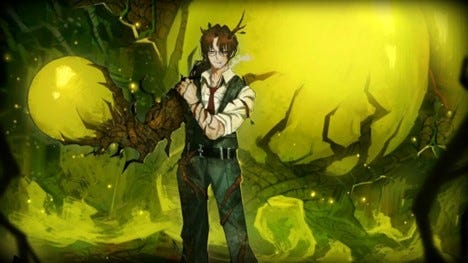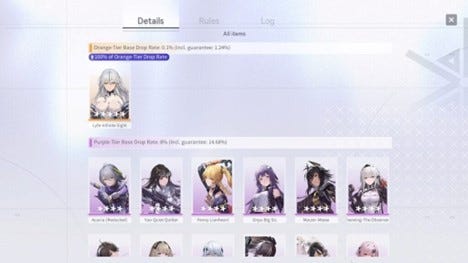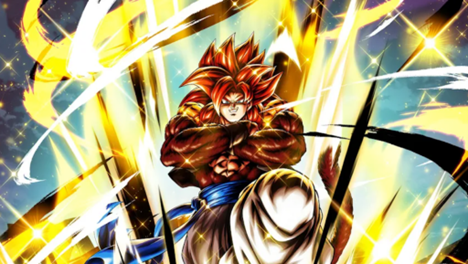Trending
Opinion: How will Project 2025 impact game developers?
The Heritage Foundation's manifesto for the possible next administration could do great harm to many, including large portions of the game development community.

Featured Blog | This community-written post highlights the best of what the game industry has to offer. Read more like it on the Game Developer Blogs or learn how to Submit Your Own Blog Post
Amazing gameplay, but at a lot of cost.

I may be one of the few people who spends their days checking out and covering the hottest and most original indie games, to then play a mobile game like Arknights, or Limbus Company. For many people, mobile games reached their peak with either Candy Crush Saga or Angry Birds and there haven’t been any games since.
But the market itself saw huge growth and change from around 2017-on, with impressive looking, and deep gameplay that would put some AAA games to shame. MihoYo has gone from being unknown to very much on par with Valve or peak Blizzard in the mobile space with the successes of their titles. But no matter how big these games are, no matter how successful they are, there is always the caveat of unethical monetization that is the foundation of these games, and that makes it very hard to have a discussion about them.
The mobile/gacha market expanded rapidly in the 2010’s, and yearly ESA surveys now cite that mobile is the most played platform of all games by a large margin. Before, mobile was looked at as something for a mom or grandparent to play when they’re bored or have a few minutes to spare. Today, you have titles with impressive stories, beautiful graphics, and advanced gameplay that continue to expand month after month.
There is a whole generation of gamers who have grown up with the understanding that playing games for “free” is the best way to experience them. But the dark truth is that no matter how “free” these games are to play, the allure of spending money is always there. I have spent money when I’ve played a few mobile games like Arknights and Limbus Company, but I can tell you that the thought of just loading up a game, dropping $500 or more on a whim for a good character or a six-star equipment piece has never crossed my mind.

content in gacha design has to be balanced between being good for the game, and a means to bring in money. (Source: Limbus Company)
The mobile industry exists in a strange catch-22 — these games are supported for years to come at a rate that most studios could never realize, but that support comes with having a massive amount of income each month. Everyone on PC has expressed their hatred over Diablo Immortal, but that didn’t stop it from making over 500 million dollars like it was nothing.
I want to curtail a few defenses people are going to throw my way about gacha design. The first one is the ever popular, “but you don’t need to spend money to enjoy them.” The entire act of gacha design is to instill FOMO (fear of missing out) in the consumer base — if you don’t acquire that new six-star character, then your account is ruined, or that amazing new character will fit your team perfectly and you need to have them. There will always be people who will play these games using nothing but the free characters, but at the end of the day, to experience everything these games have to offer, you are going to seek those six stars.
Every gacha game I’ve played, whether intentionally or not, has inherent pain points and difficulty spikes for new players or accounts that aren’t powered up yet. With Limbus Company, by being there at the literal start of the game, my account now has access to every single piece of content in the game, and I have only spent about $40 for the different season passes. There are some fights in it that I can’t imagine a new or unlucky account ever having the means to win. Arknights can also be painful in some of the early chapters, I remember having problems with chapters 5 and 6 as I had no good ranged characters or six-stars to help me. Another defense I want to curtail is the “but you can add friends and request character” feature that many character collector mobile games have. I don’t like this feature as it acts as more of a Band-Aid fix for the inherent difficulty spike problems.

Hard and soft pity systems, are good ideas, but low drop rates are still a major obstacle (source: Snow break Containment Zone)
It’s a hard line to walk when you’re designing the pacing and flow of these games — if you want people to go after six-star characters, then you need to design content that makes them interesting to use. But designing content around them will also make it worse for the people who don’t have access to them.
The other defense people will bring up is the use of pity systems — where after X amount of pulls, you are guaranteed a six-star or featured character. I think a hard pity system on every banner should be the industry standard, full stop. However, no one has a good idea of what should be a standard hard pity. In some games, the “pity” may still require over a hundred dollars per banner, and players may only earn enough free currency for 1 to 2 10-pulls a month.
When I tried out the game Nikke, I reached a hard limit on account progress placed by the developer. Even though the game has an excellent pity system, I couldn’t make any more progress unless I could get enough copies of the same highest-rated characters so that all my other characters scale up to them. At that point, either I had to get super lucky with my pulls, or just spend lots of money on pulls, so I did neither and quit playing.
You, of course, need content to push accounts and be the late game uber challenges for people to enjoy, but if someone is getting locked out in the middle of your story content because of money and luck, they’re never going to reach those challenges. What I’m finding with a game like Arknights is that I’m starting to run out of gas with its late-game challenges. Yes, I have a lot of great characters, but it will take grinding to level them all up, and even then, it’s going to add more time to a game where my time is already limited with everything else I have to do.
No matter how great a game is, I don’t think I’m the consumer who could ever play a “main game” live service title — or one that demands your time day-after-day in order to progress. If I must dedicate more than 10 minutes daily to a mobile game outside of new content, I’m going to stop playing. I’m also in favor of removing the requirement for daily play resource collecting as forced play is not ethical design.
The original idea for live service games was this notion that the game continues to grow beyond the initial retail purchase or release — that the game should be fundamentally a different experience year two, three, five, etc. What we’ve found however is that even in the most successful and biggest live service games, that doesn’t happen. You can argue with me that games like Destiny 2, Fortnite, Arknights, Genshin Impact, or any other successful multi-year supported game has grown and changed, but has it?
What I’ve seen from all the live service games I’ve studied is that no matter how much people want to call them “forever games”, no matter how much content and banners and battle passes and FOMO, these games in truth never change, and the reason why is quite simple, everything is locked to the monetization model. Instead of the gameplay driving the monetization, the monetization drives the gameplay. So what ends up happening is that the gameplay loop in year 1, is the same in years 3,5,7, whatever. You can’t introduce content on par with an expansion or a sequel in a live service game, because everything is tied to the monetization. One exception is the sheer amount of new modes and systems introduced in Warframe, and how the developers have found a lot of mileage out of their same gameplay loop.

Dragon Ball Legends is one of the few mobile games to have added in new rarity tiers, and new drop rates to with it, with the same gameplay (source: DB Legends)
If you introduce a new game mode, a new enemy type, a new weapon, hero, class, etc. that inherently breaks or doesn’t use the content that’s already in the game, consumers will riot, because you are creating content that all the monetization that has led up to your game doesn’t support. Imagine telling someone who has spent $1,000+ on a single game that the next content update is going to introduce something that everything they’ve spent money on doesn’t apply to it.
Instead, new content adds breadth, not depth to a game. Yes, the levels may be more advanced, or the enemies stronger or different to fight, or that new six-star has a crazy new power to them, but it doesn’t change or grow the initial gameplay loop that was set year 1, day 1, minute 1 of that game being launched. This is the point when someone is going to write “who cares?” If the gameplay on day 1 was fantastic, then having 5 years of that content would be great, right? Not growing your game or taking years to make simple additions leaves these titles in a strange position. They may have huge growth and get massive recognition, but then they all start to stagnate — new players aren’t joining because they find the idea of starting fresh in a game with years of support overwhelming. And people who aren’t whales will start to get tired and stop playing and paying eventually.
At some point, every single live service game hits its peak and plateaus — no matter what new content they put out, what mega-amazing collab they have coming, people are not joining or coming back. For the big-name games, they still are a license to print money…just less money than they were before.
Where Do These Games End Up?
There is one other point I want to bring up that frustrates me to no end — end of service for mobile games. The beauty of digital games is the very fact that they can be downloaded and played for a long time, but the mobile market is woefully behind in this respect. While you may love or hate them, there are thousands of mobile games released over the 2010’s that are gone — they went end of service, the server is shut off, and those games and all the time, money, energy, and fans, just disappear.

Dragon Ball Legends is one of the few mobile games to have added in new rarity tiers, and new drop rates to with it, with the same gameplay (source: DB Legends)
Some of you reading this are thinking “who cares”, but the point of game preservation is to preserve every game — the ones you love and the ones you hate. I can’t stand to think about the work of a studio over months and years of development just going up in smoke never to be seen ever again. Whether you think these games are simple or advanced, they were still developed and released and deserve to be remembered.
There is some fantastic UI/UX work in some of the better/unique mobile games, and it again, breaks the trope that these games are just simple little time wasters.
The Next Wave?
When I wrote my book on F2P design a few years ago, I was saying how more mobile and AAA developers would look to the likes of Genshin Impact as the inspiration for their games going forward. I didn’t think someone would just quite literally make a game just like it with Wuthering Waves. We haven’t seen anything new in terms of mobile design and monetization since: things have gotten flashier, but will Genshin be considered the peak of mobile design? And to that point — will there be laws here in the US put in place to stop or curtail unethical monetization?
For more on F2P/mobile design, be sure to pick up Game Design Deep Dive: F2P
If you would like to support what I do and let me do more daily streaming, be sure to check out my Patreon. My Discord is now open to everyone for chatting about games and game design.
You May Also Like